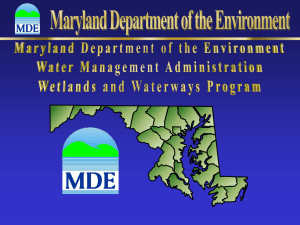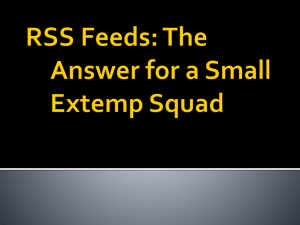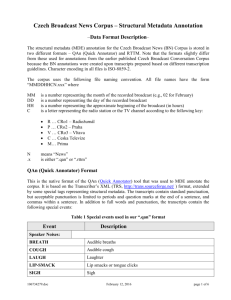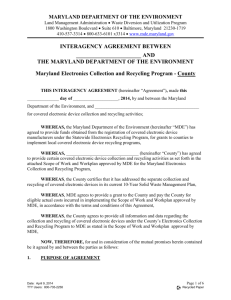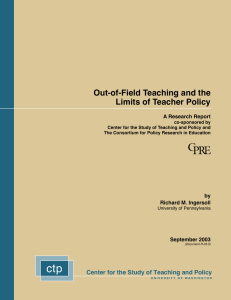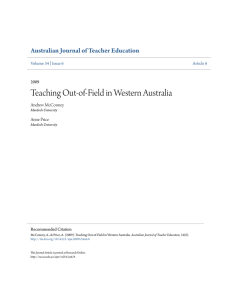Worlds Best Workforce Summary Template 2015
advertisement
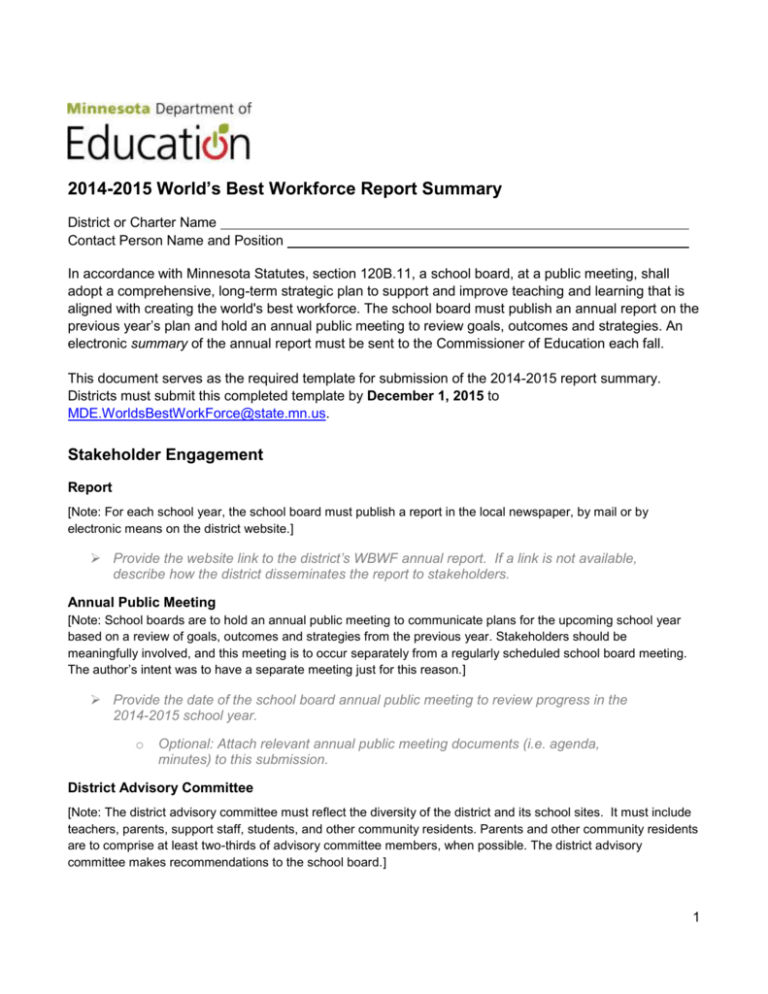
2014-2015 World’s Best Workforce Report Summary District or Charter Name Contact Person Name and Position In accordance with Minnesota Statutes, section 120B.11, a school board, at a public meeting, shall adopt a comprehensive, long-term strategic plan to support and improve teaching and learning that is aligned with creating the world's best workforce. The school board must publish an annual report on the previous year’s plan and hold an annual public meeting to review goals, outcomes and strategies. An electronic summary of the annual report must be sent to the Commissioner of Education each fall. This document serves as the required template for submission of the 2014-2015 report summary. Districts must submit this completed template by December 1, 2015 to MDE.WorldsBestWorkForce@state.mn.us. Stakeholder Engagement Report [Note: For each school year, the school board must publish a report in the local newspaper, by mail or by electronic means on the district website.] Provide the website link to the district’s WBWF annual report. If a link is not available, describe how the district disseminates the report to stakeholders. Annual Public Meeting [Note: School boards are to hold an annual public meeting to communicate plans for the upcoming school year based on a review of goals, outcomes and strategies from the previous year. Stakeholders should be meaningfully involved, and this meeting is to occur separately from a regularly scheduled school board meeting. The author’s intent was to have a separate meeting just for this reason.] Provide the date of the school board annual public meeting to review progress in the 2014-2015 school year. o Optional: Attach relevant annual public meeting documents (i.e. agenda, minutes) to this submission. District Advisory Committee [Note: The district advisory committee must reflect the diversity of the district and its school sites. It must include teachers, parents, support staff, students, and other community residents. Parents and other community residents are to comprise at least two-thirds of advisory committee members, when possible. The district advisory committee makes recommendations to the school board.] 1 Describe the makeup and list the District Advisory Committee members for the 20142015 school year. Goals and Results [Note: Goals should be linked to needs and written in SMART-goal format. SMART goals are: specific and strategic, measurable, attainable (yet rigorous), results-based and time-based. Results should tie directly back to the established goal so it is clear whether the goal was met. Districts may choose to use the data profiles provided by MDE in reporting goals and results.] SMART Goal 2014-2015 Goals 2014-2015 Goal Results All Students Ready for Kindergarten Provide the established SMART goal for the 20142015 school year. Provide the result for the 20142015 school year that directly ties back to the established goal. All Students in Third Grade Achieving Grade-Level Literacy Provide the established SMART goal for the 20142015 school year. Provide the result for the 20142015 school year that directly ties back to the established goal. Close the Achievement Gap(s) Among All Groups Provide the established SMART goal for the 20142015 school year. Provide the result for the 20142015 school year that directly ties back to the established goal. All Students Career- and College-Ready by Graduation Provide the established SMART goal for the 20142015 school year. Provide the result for the 20142015 school year that directly ties back to the established goal. All Students Graduate Provide the established SMART goal for the 20142015 school year. Provide the result for the 20142015 school year that directly ties back to the established goal. Identified Needs Based on Data [Note: Data that was reviewed to determine needs may include state-level accountability tests, such as Minnesota Comprehensive Assessments (MCAs) and/or local-level data, such as local assessments, attendance, graduation, mobility, remedial course-taking rates, child poverty, etc.] List and describe the district’s needs that were identified at the start of the 2014-2015 school year, and the data the needs were based upon. Include only the key data used to determine identified needs and limit response to 200 words. 2 Systems, Strategies and Support Category Students Describe the support offered to students during the 2014-2015 school year to meet the goals. o Include the process for assessing and evaluating student progress toward meeting state and local academic standards. o Include the process to disaggregate data by student group. o Include key indicators of progress to demonstrate evidence of implementation. o Include only the district focus areas for the 2014-2015 school year and limit response to 200 words. Teachers and Principals Describe the support offered to teachers and principals during the 2014-2015 school year to meet the goals. o Include the system to review and evaluate the effectiveness of instruction and curriculum, including teacher and principal evaluations. o Include key indicators of progress to demonstrate evidence of implementation. o Include only the district focus areas for the 2014-2015 school year and limit response to 200 words. District Describe the support offered at the district level during the 2014-2015 school year to meet the goals. o Include the district practices that integrate high-quality instruction, rigorous curriculum, technology, and a collaborative professional culture. o Include key indicators of progress to demonstrate evidence of implementation. o Include only the district focus areas for the 2014-2015 school year and limit response to 200 words. Equitable Access to Excellent Teachers [Note: Review the information below. Districts do not need to report information in this section at this time.] Section 1111(b)(8)(C) of the Elementary and Secondary Education Act (ESEA) requires that each state take steps to ensure that poor and minority children are not taught at higher rates than other children by inexperienced, unqualified or out-of-field teachers. On June 1, 2015, MDE submitted a plan to the U.S. Department of Education that required all states to address long-term needs for improving equitable access of all students to great educators. The plan was developed with significant stakeholder input and can be found on the MDE website. From MDE’s data review, the following statewide equity gaps surfaced: Schools in the highest poverty quartile are more likely to have inexperienced, unqualified and out-of-field teachers than schools in the lowest poverty quartile. Schools in the highest minority quartile are more likely to have inexperienced, unqualified and out-of-field teachers than schools in the lowest minority quartile. Priority and Focus schools are more likely to have inexperienced, unqualified and out-of-field teachers than Reward schools. 3 Charter schools are more likely to have inexperienced, unqualified and out-of-field teachers than non-charter schools. To reach the goals of the WBWF, it is important to ensure that all students, particularly students from low-income families and students of color, have equitable access to teachers and principals who can help them reach their potential. Beginning with the next WBWF summary, to be submitted in fall 2016, MDE will request information about the district process to examine the distribution of experienced and qualified teachers across the district and within school sites using data. 4
